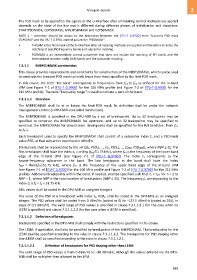Page 703 - 5G Basics - Core Network Aspects
P. 703
Transport aspects 2
The PSD mask to be applied to the signals at the U-interface after all masking control methods are applied
depends on the state of the line and is different during different phases of initialization and showtime:
STARTPSDMASK, CDPSDMASK, MREFPSDMASK and V2PSDMASK.
NOTE 2 – Attention should be drawn to the distinction between the [ITU-T G.9700] term "transmit PSD mask
(TxPSDM)" and the ITU-T G.9701 control parameter "PSDMASK".
• TxPSDM is the final mask at the U-interface after all masking methods are applied and therefore includes the
notching of specific frequency bands and subcarrier masking.
• PSDMASK is an intermediate control parameter that does not include the notching of RFI bands and the
international amateur radio (IAR) bands and the subcarrier masking.
7.3.1.1 MIBPSDMASK construction
This clause provides requirements and constraints for construction of the MIBPSDMASK, which can be used
to constrain the transmit PSD mask to levels lower than those specified by the limit PSD mask.
In this clause, the term "the band" corresponds to frequencies from ftr1 to ftr2 as defined for the in-band
LPM (see Figure 7-1 of [ITU-T G.9700] for the 106 MHz profile and Figure 7-2 of [ITU-T G.9700] for the
212 MHz profile). The term "frequency range" is used to indicate a part of the band.
7.3.1.1.1 Overview
The MIBPSDMASK shall lie at or below the limit PSD mask. Its definition shall be under the network
management control (a DPU-MIB-controlled mechanism).
The MIBPSDMASK is specified in the DPU-MIB by a set of breakpoints. Up to 32 breakpoints may be
specified to construct the MIBPSDMASK for upstream, and up to 32 breakpoints may be specified to
construct the MIBPSDMASK for downstream. Breakpoints shall be specified for the full band (i.e., from ftr1
to ftr2).
Each breakpoint used to specify the MIBPSDMASK shall consist of a subcarrier index tn and a PSD mask
value PSDn at that subcarrier expressed in dBm/Hz.
Breakpoints shall be represented by the set [(t1, PSD1), ..., (tn, PSDn), ..., (tNBP, PSDNBP)], where NBP ≤ 32. The
first breakpoint shall have the index t1 = ceiling (ftr1/51.75 kHz), where ftr1 is the frequency of the lower band
edge of the in-band LPM (see Figure 7-1 of [ITU-T G.9700]). The index t1 corresponds to the
lowest-frequency subcarrier in the band. The last breakpoint in the band shall have the index
tNBP = floor(ftr2/51.75 kHz), where ftr2 is the frequency of the upper band edge of the in-band LPM
(see Figure 7-1 of [ITU-T G.9700] for the 106 MHz profile and Figure 7-2 of [ITU-T G.9700] for the 212 MHz
profile). Additional breakpoints within the band, if needed, shall be specified such that tn < tn+1 for n = 2 to
NBP – 1, where NBP is the total number of breakpoints (NBP ≤ 32). The frequency fn corresponding to the
index tn is fn = tn 51.75 kHz.
All ti values shall be coded in the DPU-MIB as unsigned integers.
The value of the PSD at a breakpoint with index tn, PSDn, shall be coded in the DPU-MIB as an unsigned
integer. The PSD values shall be coded from 0 dBm/Hz (coded as 0) to −127.5 dBm/Hz (coded as 255), in
steps of 0.5 dBm/Hz. The valid range of PSD values is specified in clause 7.3.1.1.2.1 (for the case when no
LESM is specified) and clause 7.3.1.1.2.2 (for the case when a LESM is specified).
7.3.1.1.2 Definition of breakpoints
Breakpoints specified in the DPU-MIB shall comply with the restrictions specified in this clause.
The LESM, if applicable, shall also be specified by breakpoints of the MIBPSDMASK. The breakpoints for the
LESM shall be specified according to the rules in clause 7.3.1.1.2.2. The breakpoints for PSD shaping other
than LESM shall be specified according to the rules in clause 7.3.1.1.2.1.
7.3.1.1.2.1 Definition of breakpoints for PSD shaping other than LESM
The valid range of PSD values is from 0 dBm/Hz to −90 dBm/Hz, although the values entered via the DPU-
MIB shall be no higher than allowed by the LPM.
693

